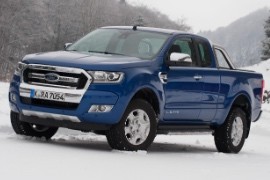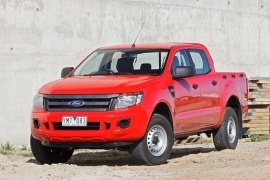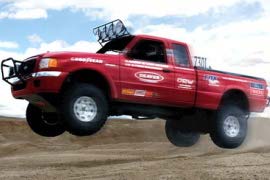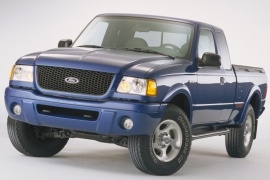FORD Ranger Super Cab Models/Series Timeline, Specifications & Photos
First production year: 2000
Engines: Diesel, Gasoline
Body style: Truck
The third generation of the European Ford Ranger was introduced in 2011. It received a facelift in 2015, raising its status from a simple, utility pickup truck, to a lifestyle vehicle.
The 2015 Ranger Super Cab was part of the Ford Ranger lineup and it was refreshed as well. Even though it wasn't a true five-seat vehicle and more of a two-seat one, it was continued and sold along the rest of its brothers with some improvements.
From the outside, the most striking modification was at the front, where a chromed grille with three wide bars was installed. The new angled headlights were swept on the fenders, like most of the SUVs on the market. The door-mirrors featured chromed cases, to enhance the adventure look even in a parking lot.
Inside, the 2015 Ranger Super Cab was offered with the new, SYNC 2 connectivity system, which was available with voice commands. It featured an 8” touchscreen with color-coded corners for easy menu navigation. The Super Cab body featured regular front doors and rear-hinged half-door in the back. Inside the cabin, there were two regular seats for the front occupants and a small bench in the back, for temporary use. It was more useful as a trunk.
The 2015 model featured an evolution of the 2.2-liter diesel engine, which was offered in two power options: 130 hp and 160 hp, respectively. The top of the range Wildtrak version was equipped with the same inline-five 3.2-liter unit good for 200 hp. Apart from the later version, all the others were available with 4x4 on-demand or two-wheel-drive. The Wildtrak was 4x4 only.
The third generation of the international version of the Ford Ranger was launched in 2011 in Australia. It was designed by Ford Australia and it also was sold in Europe.
There was a completely new chassis for the 2011 Ranger, or the T6 version as it was internally named. Destined for sale across five continents and more than 180 markets, Ford Ranger was offered as a complete family of compact trucks - with three different cab body styles, 4x2 and 4x4 drivetrains, two ride heights and up to five trim levels, depending on the market.
The new styling saw an approach toward the leisure sport-utility truck vehicles. It was the same rugged off-road vehicle, but the bodywork lines were closer to the look of an SUV. Its design also took into consideration the aerodynamic factor so the lines were smoother. The big headlights were flushed to the front fascia. To amplify the width of the car, the grille had horizontal lines and the bumper was taller than before.
The Super Cab version featured four doors, with the rear ones hinged in the back (suicidal doors). It offered four seats inside with limited knee room for the rear passengers. The dashboard was designed taking in consideration other objects, such as the Casio G-Shock sport-watch. Depending on the trim level, it offered a touch-screen infotainment system, climate control and heated seats.
Three engines were available, including a 2.2-liter inline-four-cylinder and a 3.2-liter inline-five. For specific markets, there was also a new 2.5-liter Duratec four-cylinder gasoline engine that Ford says will have more power than its major competitors and is flex-fuel capable. For the transmission, the Ranger was offered in a 4x4 or 4x2 configuration, with a 5-speed manual or 6-speed automatic.
Ford introduced the Ranger nameplate on the North American continent for its compact pickup segment and proved to be more successful than expected.
The blue-oval brand unveiled the Ranger's third generation in 1998 and looked very similar to its predecessor. In 2007, when the world financial crisis struck, Ford understood the market's need for a lower budget pickup and burned the midnight oil to launch a facelifted version of its already ten-years-old compact pickup.
At the front, it featured a front fascia that resembled the F-series, with its three-slats grille and two vertical openings that flanked them. Even the headlights looked similar, although they were scaled down. For the base version, the car featured black bumpers. The Ranger was available with a 6 ft (1.82m) bed in the Super Cab version and a cabin fit for four. Ford offered the compact pickup in three trim levels: XL, XLT, and Sport and exclusively for the SuperCab as FX4. The latter added 16" alloys, heavy-duty suspension and AT tires fitted as standard.
Ford offered the Ranger with suicide-doors in the rear and two jump-suits where a kid could sit for a short distance. The same area could have been used as small storage for a bucket of paint. The rest of the interior was the same, with easy-to-use controls. If they worked, Ford didn't bother changing them.
Under the hood, the carmaker offered a choice of three engines, starting with the fuel-efficient 2.3-liter gasoline. The range-topper was the 4.0-liter V-6 paired to a 5-speed manual.
FORD Ranger Super Cab 2.3L 5AT (143 HP)
FORD Ranger Super Cab 2.3L 5MT (143 HP)
FORD Ranger Super Cab 3.0L V6 5AT (148 HP)
FORD Ranger Super Cab 3.0L V6 5AT AWD (148 HP)
FORD Ranger Super Cab 3.0L V6 5MT (148 HP)
FORD Ranger Super Cab 3.0L V6 5MT AWD (148 HP)
FORD Ranger Super Cab 4.0L V6 5AT (207 HP)
FORD Ranger Super Cab 4.0L V6 5AT AWD (207 HP)
Ford introduced the third generation of its light pickup-truck in 1997 as a 1998 model, but two years later, it offered the Super Cab version, with a few other improvements.
While the F-Series was the king of pickup-trucks, its smaller brother Ranger tried to make its way on the market. Unlike its European sibling, which was offered with a diesel engine, the American version was fitted exclusively with gasoline units and, in the Super Cab version, with plenty of room behind the seats.
Ranger didn't have to be ashamed with its bigger brothers. To show that, it featured a similar front fascia, with the classic black grille. Unlike the non-facelifted, 1998 model, the 2000 Ranger featured different headlights, with the turn-signals installed on the headlights' outer side and not underneath them. Another important modification was the plastic front bumper, which replaced the previously used metallic, chromed one. Both vehicles were very similar in the back, with just a few touches on the tailgates for the 2000 model.
Inside, the Ranger was a mix between a pickup and a regular car. The center stack featured the climate controls and the stereo. Ford chose to install a column-shifter for vehicles fitted with an automatic transmission, while for those with a manual, Ranger had a floor-mounted gear-stick. Behind the seats, there was a space good for tools or some luggage. Unlike the bigger versions, it didn't feature rear seats, but at least had some in-cabin storage compartment.
Ford offered the Ranger with a choice of V6 or V8 engines, rear or all-wheel-drive.



